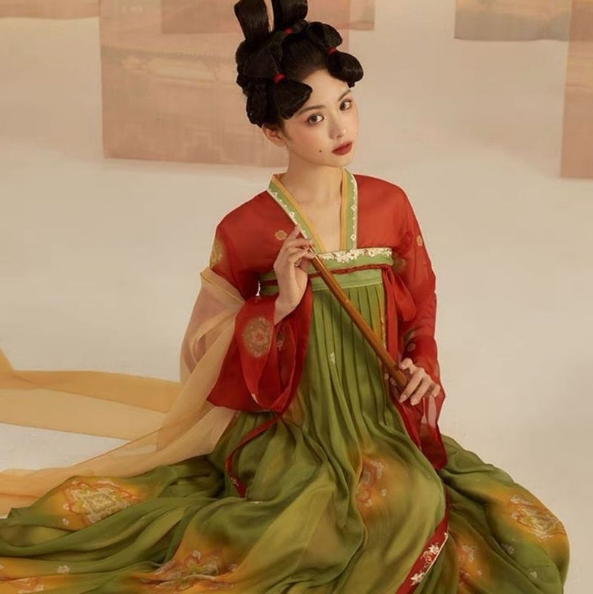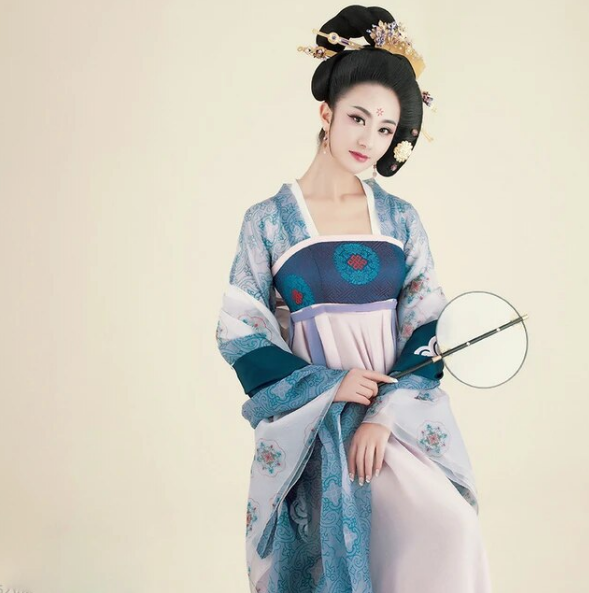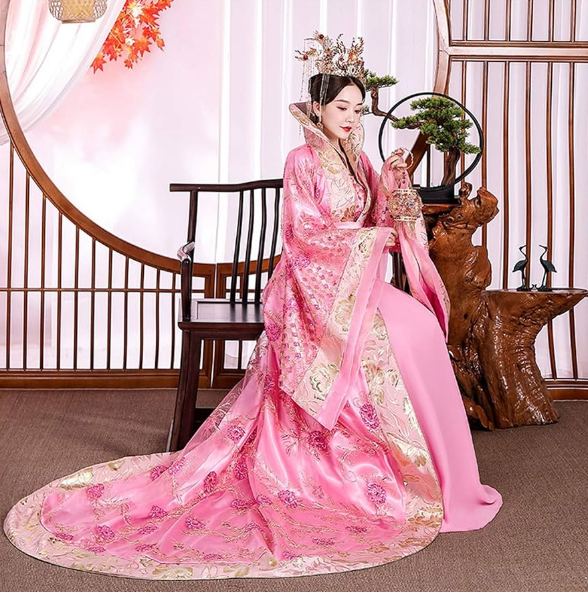Historical Overview of Tang Dynasty Fashion
The Tang Dynasty, a period of great prosperity and artistic achievement, stands out in Chinese history for its fashion. During this era, clothing not only served functional purposes but also represented social status and cultural identity. This era, known for its openness and cosmopolitan nature, witnessed the emergence of distinct fashion styles that were influenced by various factors, including the Silk Road and international trade.
Evolution of Royal Attire
Initially, Tang Dynasty royal attire reflected traditional Han Chinese clothing styles. However, as the dynasty progressed, it began incorporating more diverse elements. The royal wardrobe, rich in variety, showcased garments such as the ‘Pao’, ‘Ru’, and ‘Shan’. The ‘Pao’ was a type of robe, often elaborately decorated and used for formal occasions. The ‘Ru’ was a blouse worn with a skirt, signifying elegance and grace. Furthermore, ‘Shan’, a kind of coat, became popular for its comfort and practicality.

Influences from Silk Road
The Silk Road, a network of trade routes connecting China to the Middle East, Europe, and Africa, played a crucial role in shaping Tang fashion. This trade network facilitated the exchange of goods, ideas, and cultural practices. As a result, Tang attire began to exhibit influences from foreign lands. For example, the use of Persian patterns and Indian fabrics became common. The incorporation of exotic styles and materials, such as Central Asian fur and Byzantine gold thread, added a unique flair to Tang clothing, distinguishing it from previous dynasties.
This fusion of styles not only symbolized the Tang Dynasty’s openness to foreign cultures but also its status as a global power. The impact of these foreign influences is evident even in modern interpretations of Tang fashion, which continue to celebrate this era’s rich and diverse sartorial heritage. For more detailed information about Tang Dynasty fashion and its influences, you can explore the Wikipedia page on Chinese clothing.
Materials and Fabrics in Tang Court Costumes
The Tang Dynasty, renowned for its luxurious court life, placed a high emphasis on the quality and variety of materials used in its costumes. Silks and brocades, the mainstays of Tang court attire, were symbols of wealth and status. These materials, often sourced from the finest silk-producing regions, displayed the dynasty’s capability to produce and procure high-quality fabrics.
Silk and Brocade Varieties
Silk, a hallmark of Chinese culture, reached its pinnacle during the Tang Dynasty. The era witnessed the production of numerous silk varieties, including lightweight, transparent weaves for summer and thicker, more insulated types for winter. Brocades, a richer and more decorative form of silk, featured heavily in court attire. These brocades, often interwoven with gold and silver threads, depicted intricate scenes from nature and mythology, showcasing the artisans’ extraordinary craftsmanship.
Use of Precious Stones and Embellishments
In addition to luxurious fabrics, Tang court costumes often featured embellishments with precious stones and pearls. Artisans skillfully embedded these embellishments into clothing, enhancing their elegance and opulence. The use of jade, a stone deeply revered in Chinese culture, was particularly popular. It was common to see court costumes adorned with jade buttons and appliques, symbolizing nobility and moral integrity. Gold and silver, too, played a significant role in decorating court attire, often used to highlight the edges of garments or as detailed embroidery.
The combination of these materials and embellishments not only reflected the wearer’s status but also the Tang Dynasty’s wealth and its connections along the Silk Road. The diversity and quality of these materials set a high standard in textile production, influencing Chinese fashion for centuries to come. For further insights into the textile industry of ancient China, you can refer to the Wikipedia page on Silk.
Design and Aesthetics
The Tang Dynasty’s court attire stands as a pinnacle of ancient Chinese fashion, showcasing a blend of elegance, sophistication, and artistic expression. The design aesthetics of this era not only reflected the social status and personal taste of the wearer but also echoed the dynasty’s cosmopolitan nature and cultural affluence. Detailed and meticulous, these designs incorporated a balance of form, function, and symbolism, setting a trend that influenced subsequent fashion eras in China.
Color Symbolism in Court Attire
Colors in Tang Dynasty court attire were far from random; they carried deep symbolic meanings and conveyed messages about the wearer’s rank and status. For instance, yellow, exclusively worn by the emperor, symbolized the center of the universe and power. High-ranking officials often wore purple, signifying nobility and wisdom, while green was commonly associated with youth and growth. The use of red, a color representing good fortune and joy, was prevalent in many court garments, especially during celebrations and festivals.
Patterns and Motifs
Patterns and motifs in Tang court attire were not only decorative but also laden with cultural significance. Dragons, a symbol of imperial power and strength, featured prominently in the emperor’s wardrobe. Phoenixes, representing beauty and good fortune, were common in the empress’s attire. Floral motifs, such as peonies and chrysanthemums, symbolized prosperity and longevity. These patterns, meticulously woven or embroidered into the fabric, demonstrated the high level of skill and artistry of Tang Dynasty craftsmen.
The designs of Tang court costumes, rich in symbolism and beauty, provide a fascinating glimpse into the cultural and aesthetic values of the era. They reflect a society that valued artistic expression and conveyed its beliefs and values through the medium of clothing. For more information on the cultural significance of these designs, the Wikipedia page on Chinese art offers valuable insights.
Royal Garments and Accessories
The royal garments and accessories of the Tang Dynasty were not just attire but symbols of imperial power and cultural sophistication. These items, crafted with meticulous attention to detail and quality, showcased the high standards and artistic prowess of Tang-era artisans. The regalia of the emperor and empress, in particular, were embodiments of their supreme status and the cultural richness of their reign.
Emperor and Empress’s Regalia
The emperor’s regalia were a stunning display of authority and dignity. His dragon robe, featuring the mythical creature as a symbol of his power, was usually made of the finest silk and adorned with gold thread. The empress’s attire was equally magnificent, often embroidered with phoenixes to represent her grace and virtue. Both the emperor and empress wore robes with long, flowing sleeves, symbolizing their reach and influence. Their outfits, rich in color and texture, were distinct markers of their elevated status in the court.
Headdresses and Footwear
Headdresses were a crucial part of Tang royal attire, with designs varying according to rank and occasion. The emperor’s crown, often adorned with pearls and precious stones, signified his supreme rule. The empress’s headdress, elaborate and ornate, was usually decorated with intricate beadwork and jewels. Footwear, too, played an important role in the royal wardrobe. Shoes were made of fine leather or silk, often embroidered with symbols matching the rest of the attire. This footwear was not just practical but also a mark of the wearer’s noble standing.

These garments and accessories, rich in symbolism and artistry, provide a window into the lavish lifestyle and cultural values of the Tang court. They highlight the dynasty’s commitment to beauty, craftsmanship, and the display of imperial authority. To delve deeper into the historical context and significance of these royal items, one can explore the Wikipedia page on Chinese clothing.
Ceremonial Attire and Occasions
In the Tang Dynasty, ceremonial attire was a significant aspect of court life, intricately linked with various rituals and celebrations. These garments, rich in symbolism and artistry, played a pivotal role in showcasing the grandeur and cultural richness of the era. The attire for different occasions, such as weddings, coronations, and festivals, varied greatly, reflecting the importance and nature of each event.
Wedding and Coronation Outfits
Wedding attire in the Tang Dynasty was a lavish display of elegance and prosperity. Brides typically wore red, a color symbolizing good luck and joy, with intricate gold or silver embroidery. The groom’s attire was equally splendid, often featuring auspicious symbols like dragons for power and success. Coronation outfits were even more magnificent. The emperor’s coronation robe, adorned with dragons and other imperial motifs, symbolized his ascent to the throne. The empress’s coronation dress, often embroidered with phoenixes, signified her grace and importance in the empire.
Festival and Ritual Clothing
Festival and ritual clothing in the Tang Dynasty varied according to the event. During the Lunar New Year and other major festivals, people wore bright and colorful garments, often decorated with symbols of good fortune and happiness. Ritual attire, used for religious and ceremonial events, was more subdued yet elegant, with a focus on harmonious colors and patterns that reflected the solemnity of the occasion.
These ceremonial garments, each with its unique significance and beauty, played a crucial role in the cultural and social life of the Tang Dynasty. They not only added to the vibrancy of festivals and rituals but also reinforced social hierarchies and cultural beliefs. For more in-depth knowledge about the cultural practices of the Tang Dynasty, the Wikipedia page on Chinese festivals provides comprehensive insights.
Cultural Legacy and Modern Interpretations
The Tang Dynasty’s fashion legacy extends far beyond its historical timeline, influencing modern design and aesthetics significantly. This era, known for its artistic and cultural achievements, continues to inspire contemporary fashion designers and artists. The integration of Tang styles into modern clothing demonstrates the timeless appeal and enduring influence of this golden age of Chinese culture.

Influence on Contemporary Fashion
Contemporary fashion designers often draw inspiration from the Tang Dynasty’s rich palette and intricate designs. Modern interpretations of Tang attire feature flowing silks, vibrant colors, and elaborate patterns, adapted to suit today’s fashion sensibilities. Designers blend traditional elements, like the broad sleeves and flowing robes of Tang dresses, with modern cuts and fabrics, creating a fusion that appeals to a global audience. This blend of ancient and modern styles not only pays homage to China’s rich cultural heritage but also showcases the versatility and relevance of traditional designs in the contemporary world.
Preservation and Exhibition in Museums
Museums around the world play a crucial role in preserving and exhibiting Tang Dynasty attire, providing a window into the past for modern audiences. These institutions meticulously preserve ancient garments, accessories, and textiles, safeguarding them for future generations. Exhibitions dedicated to Tang fashion not only display the physical items but also provide historical context, explaining the cultural significance and craftsmanship behind each piece. This preservation effort ensures that the legacy of Tang Dynasty fashion remains accessible and appreciated, contributing to a broader understanding of China’s rich cultural history.
The cultural legacy of the Tang Dynasty’s fashion continues to resonate in modern times, bridging the gap between ancient artistry and contemporary style. For further exploration into the impact of Tang fashion on modern design, the Wikipedia page on the History of Chinese Fashion offers detailed insights.







